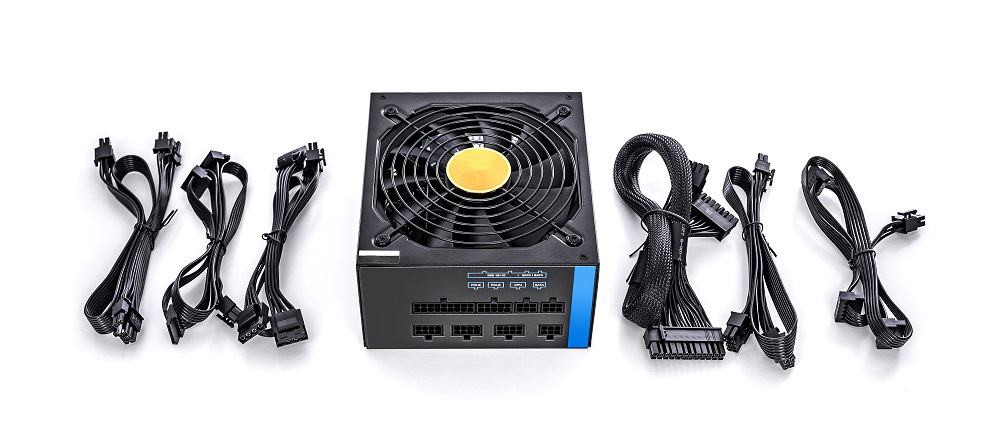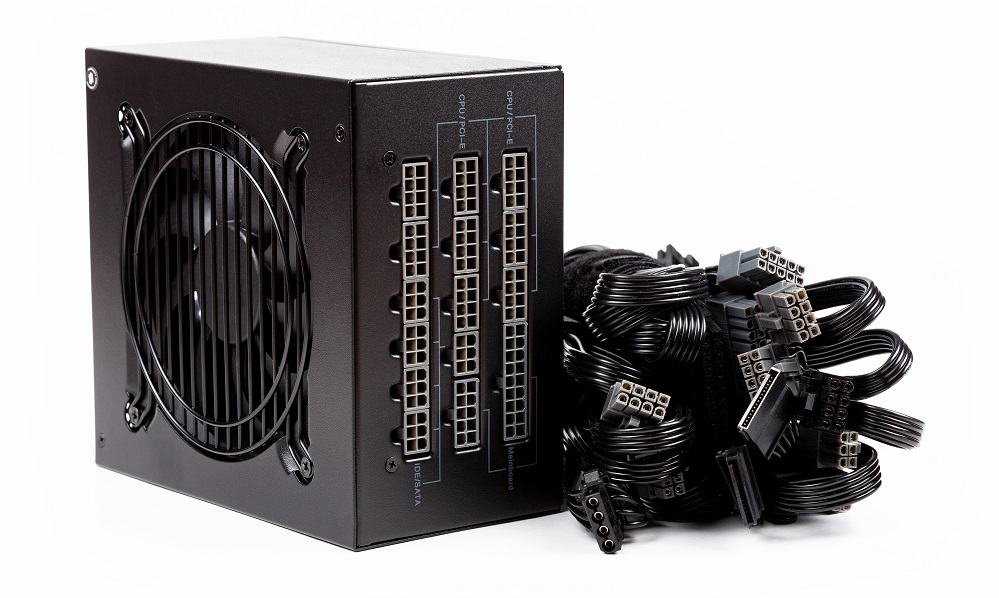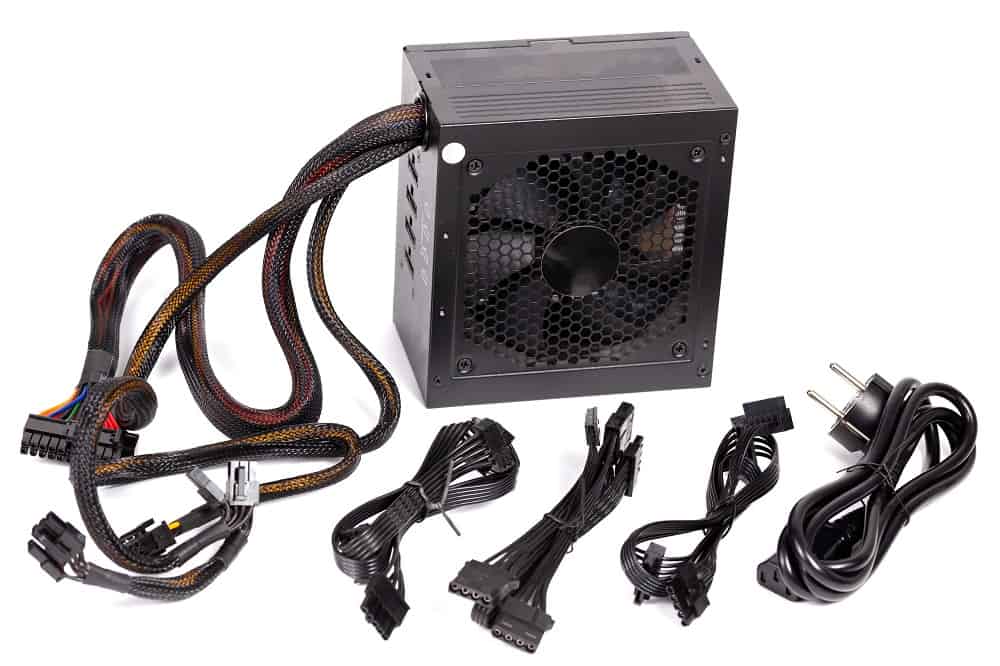The Power Supply Unit (PSU) is one of the most important components in any computer system. It converts alternating current (AC) utility power, to direct current (DC) voltages, suitable for powering the various computer system components, such as the motherboard, CPU and GPU, peripheral cards, hard disk drives, solid state drives, CD/DVD/Blu-ray drives, and other ancillary devices.
In order to supply power to all these components, the PSU provides connections, either as a permanent loom of cables, or through several outlets with various pinout configurations, intended to be connected to the system’s devices and boards using modular cables as and when required.
Older PSUs came with all cables permanently attached to the PSU. Today’s modular PSUs, either have no cables attached at all, and the system builder attaches only those cables that are required, while others come with the most basic cables permanently attached, and any other cables are attached as required.
Introduction to Power Supply Units (PSUs)

When building a computer system, there are several considerations to take into account. Among them:
- How much power the system will draw, not only to cover current, but also future needs.
- How many devices will be attached and how they will be supplied with power.
- Will the default cooling system be enough, or will something more sophisticated be required.
- What is the size of the computer case and how much room is available.
In all of the above, the PSU has either a direct or indirect influence.
Every PSU has a power rating expressed in watts (e.g. 650W), that indicates the maximum total power it can supply. When putting together a computer system, the designer must take into consideration what cards and devices will be installed and calculate the system’s total power requirements.
Some computer systems require high end graphics cards or even multiple graphics cards (using Nvidia SLI or AMD Crossfire). When taken to their limits, these cards can draw quite a lot of power, which means they will generate a lot of heat.
CPUs can also generate a lot of heat, especially when overclocked, but also when put under continuous, heavy load. In order for the heat generated by the CPU and GPUs to be effectively expelled, an efficient airflow must be maintained.
One of the best ways to maximize airflow inside a computer case, is to keep power cables tidy and out of the way (referred to as cable management), allowing the intake and exhaust of air to be obstruction-free.
Older PSUs had their power cables permanently attached, which meant any cables that weren’t connected to a board or device, had to be somehow tied together in a clump and tucked away to the side.
However, this was not always easy to accomplish, especially given the variety of computer cases, each with its own layout and space restrictions.
To cut down on unused power cables cluttering up space, newer modular PSUs come with either no cables attached or only the bare minimum attached, and are labeled as fully modular and semi-modular, respectively. In these cases, power cables are only connected when needed, keeping the clutter to a minimum.
Almost all modern PSUs, regardless of whether they are fully or semi-modular, offer Over Voltage Protection (OVP), Under Voltage Protection UVP), Over Current Protection (OCP), Over Power Protection (OPP), Short Circuit Protection (SCP), and Over Temperature Protection (OTP).
One other factor to consider with modern PSUs is their power efficiency rating. Both fully and semi-modular PSUs can be assigned one of these ratings.
- 80 Plus rating.
The PSU is rated for at least 80% efficiency at 20% load, 50% load, and 100% load. - 80 Plus Bronze rating.
The PSU is rated for at least 82% efficiency at 20% load, 85% at 50% load, and 82% at 100% load. - 80 Plus Silver rating.
The PSU is rated for at least 85% efficiency at 20% load, 88% at 50% load, and 85% at 100% load. - 80 Plus Gold rating.
The PSU is rated for at least 87% efficiency at 20% load, 90% at 50% load, and 87% at 100% load. - 80 Plus Platinum rating.
The PSU is rated for at least 90% efficiency at 20% load, 92% at 50% load, and 89% at 100% load.
Fully Modular PSU

The term modular refers to the ability to remove and add parts as and when needed, and in particular to the cables and connectors on a PSU.
A fully modular PSU is one where no power cables come permanently attached. Cables are supplied and used only when required. The PSU has clearly marked connections (outputs) on one side where the cables are plugged in.
A typical list of PSU connections and cables supplied is given below. While cable connections at the motherboard, expansion board, and device end are standard, unfortunately, there is no such standard for connections and pinouts at the PSU end of the cable, and each manufacturer has their own set of cables that connect only to their PSUs.
Cable Description |
Connector Quantity |
Purpose |
Typical Cable Length |
ATX Cable 24 pin |
1 |
Supplies power to the motherboard |
600mm |
EPS/ATX12V |
2x 8pin (4+4) |
Supplies power to the motherboard CPU socket |
650mm |
PCIe 8 pin |
4x 8pin (6+2), 2x 6pin |
Used to provide extra 12V power to PCIe expansion cards. |
750mm |
SATA Cable (4 SATA - Right Angle) |
12 |
Connects host bus to mass storage devices. There are 4 connectors per cable, |
550mm + 100mm + 100mm + 100mm |
Peripheral cable (4-pin) |
4 |
Powers fans, optical drives, older HDDs |
500mm + 150mm + 150mm +150mm |
Obviously, there has to be power supplied to the motherboard (ATX cable) and the CPU (EPS cable) so that the system will at least start. Beyond this, depending on the installed graphics card(s) (PCIe cable), mass storage devices (SATA cables), fans, optical drives and other similar devices (peripheral cable), these will also need power.
The benefit of a fully modular PSU, is that only those cables required are used. This not only makes cable management much simpler, but also space inside the computer case is kept clutter free, allowing for more efficient air flow.
Semi-modular PSU

With semi-modular PSUs, the ATX 24 pin and EPS are permanently attached to the PSU. The remaining cable connections (PCIe, SATA, and peripheral) are optional and are attached only when required. Other than this, there is no other functional difference between semi-modular and fully modular PSUs.
Considering that the ATX 24 pin and EPS cables are the minimum power connections required in any system, there is no real advantage or disadvantage compared to a fully modular PSU. The level of flexibility offered by a semi-modular PSU is also the same.
Conclusion
There’s no denying the benefits of fully and semi-modular PSUs over the older, non-modular PSUs. The greatest gain is the flexibility offered in cable management, which allows for a tidy, uncluttered case. More importantly, this leads to far better air flow and heat dissipation efficiency.
Both fully and semi-modular PSUs also come with a number of voltage, current, power, and temperature protections, as well as power efficiency ratings.
Another benefit is when the PSU, possibly a faulty one, ever needs to be replaced, it is much easier to unplug and plug power cables at the PSU end, than at the motherboard or device end. Consider the three cases of replacing a fully modular, semi-modular, and non-modular PSU.
Assuming that the same PSU is used, or one from the same manufacturer so that the cables and connectors remain intact (cables between manufacturers are not interchangeable), removal and installation of a fully modular PSU only requires unplugging the power cables from the faulty PSU and reattaching them to the new one.
With a semi-modular PSU, only the ATX 24 pin and EPS cables need to be unplugged from the motherboard, all other cables can be detached at the PSU, as long as (just as with the fully modular PSU), the same PSU or one from the same manufacturer is used.
Finally, the same scenario, but with a non-modular PSU. All power cables would need to be unplugged from the motherboard, expansion cards, and devices, before the PSU can be removed from the case. When the new PSU is installed, all cables must be reconnected.
The difference between fully and semi-modular PSUs is negligible. On semi-modular PSUs, only the ATX 24 pin and EPS are permanently attached, which are the minimum power cables required on any PC system anyway.
The only instance where it would be preferable to have these cables detachable, would be in fully customized designs in which fancy designer cables will be used instead of those supplied by the PSU manufacturer. This may be the preference for enthusiast and gaming PCs.
One final consideration is cost. A fully modular PSU tends to be slightly more expensive than the equivalent semi-modular PSU.

